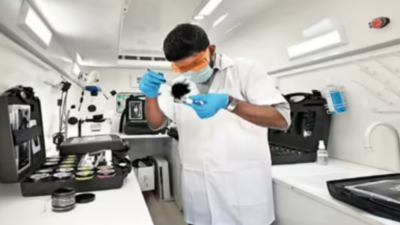ARTICLE AD BOX

MUMBAI: It begins with a scene we’ve seen too many times before. A quiet room, a pool of blood, a flashlight beam slicing through shadows, and the sharp gaze of a forensic scientist reading stories left behind.
But beyond the grim glamour of prime-time crime shows, there lies a quieter marvel—one that unfolds not in interrogation rooms but under microscopes. It begins not with who did it, but how a single drop of blood dries.In a study by IIT Bombay researchers Rajneesh Bhardwaj and Amit Agrawal that straddles the intersection of physics, biology, and forensics, researchers at the Indian Institute of Technology (IIT) Bombay examined something oddly overlooked: how the angle of a surface changes the way a drop of blood dries—and cracks.
The idea sounds simple. But as with most simple things, it hides a world of complexity.To picture it, imagine a solitary drop of blood—no bigger than a raindrop—resting on a glass slide. As the water within begins to evaporate, it leaves behind its hidden contents: red blood cells, proteins, salts. These begin to arrange themselves, drawn outward by invisible currents until they form strange, intricate rings. Scientists call this desiccation, and far from being random, the patterns it produces carry signatures—of how the blood landed, how much there was, and the slope it landed on.
Blood, like people, behaves differently under pressure. On a flat surface, it settles into a familiar shape: a circular ring, much like the stain left by a drying coffee cup. This happens because evaporation occurs fastest at the edges, and with that comes a pull—a radial outward flow dragging particles from the centre to the rim. Left behind is the so-called “coffee ring effect,” dense with cells, framed with cracks.But life isn’t always level. Tilt the surface, and a new force enters the equation: gravity. It nudges the droplet downhill, straining the harmony that surface tension fights to preserve. The droplet elongates, becomes asymmetric. Its bottom edge—called the advancing front—slides forward; the top, or receding edge, holds back. This subtle deformation introduces a quiet chaos.Heavier particles like red blood cells give in to gravity more readily and collect on the advancing side.
The lighter components—proteins and salts—still follow the evaporation-driven flow, tending toward the receding edge. The result? A natural sorting mechanism. And in that sorting lies the key to understanding how these drying patterns form—and how they fracture.To explore this, the researchers experimented with different volumes of blood, ranging from tiny one-microlitre droplets, no bigger than a pinhead, to larger ten-microlitre blobs.
Each drop was allowed to dry on surfaces tilted from a flat 0 degrees to a steep 70. High-speed cameras captured the drying in real time. Microscopes then revealed the dried aftermath in astonishing detail.What they found was a universe in miniature: asymmetric deposits, evolving crack formations, and a delicate interplay of forces. The blood didn't just dry differently; it fractured differently too. Where the deposit was thicker—typically on the advancing edge—the stress during drying built up more.
Cracks here were wider and spaced farther apart. On the thinner, receding side, the cracks were finer and more closely packed.To explain this behaviour, the team turned to a classic principle from materials science: the Griffith criterion. It states that a material cracks when the energy released by the fracture is enough to overcome the energy required to create new surfaces. In the case of blood, these surfaces include the interface between the blood and air, and between the blood and the glass slide.Based on this, the researchers built a mathematical model, linking crack formation with the thickness of the dried deposit. It suggested that the thicker the deposit, the more energy it stores, and the easier it is to crack wide and deep. On the thinner side, the energy dissipates more quickly, resulting in finer cracks. This gradient creates not just asymmetry in appearance—but in meaning. Because cracks, it turns out, can tell tales.What if we could reverse-engineer a crime scene from a single droplet of blood? That’s what this research hints at. By studying the cracks, scientists may be able to determine the original volume of the droplet and even the angle at which it struck the surface—vital clues for forensic reconstruction. In this way, blood becomes not just a witness but a narrator.Of course, not everything went according to theory. Occasionally, instead of forming central plaques, some larger drops produced a curious central bulge—seemingly at random.
These anomalies, the researchers note, are likely due to unpredictable flow instabilities during the drying process. They are still trying to understand why they appear only in some instances and not others. The mystery, as in so many good investigations, remains partly unsolved.But the implications stretch far beyond crime scenes. These patterns may also differ depending on the health of the person whose blood was spilled.
Preliminary studies suggest that diseased blood dries differently from healthy blood—possibly due to altered protein content or viscosity. This opens the door to using desiccation patterns as potential diagnostic biomarkers.Then there’s the role of surface properties—specifically, wettability. A surface’s ability to attract or repel water can alter the blood’s spread and subsequent drying patterns. The IIT Bombay team plans to delve into this next, adding yet another layer to their already intricate inquiry.For now, the team has drawn a compelling map between physics and forensic science, using something as humble—and as profound—as a drying bloodstain. They’ve shown that even in its final moments on a surface, a drop of blood resists silence. It fractures, it flows, it tells. The stories aren’t always easy to read, and they’re certainly not always complete. But they’re there, etched in rings and cracks, in coronas and creases, waiting for the right kind of reader.And sometimes, all it takes is a slight tilt—to see what was always hidden in plain sight.



.png)
.png)
.png)
















 5 days ago
6
5 days ago
6









 English (US) ·
English (US) ·